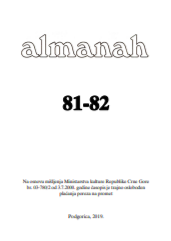Author(s): Tatjana Đurišić-Bečanović / Language(s): Serbian
Issue: 11/2014
This paper analyzes the functions of spatial codes in the two most important novels of the twentieth century, written by two famous Montenegrin writers: Mihailo Lalic and Miodrag Bulatovic, examining the semiotics of the Montenegrin chronotope, artistically incorporated in their texts, pointing out very significant activity codes as the integration of spatial factors of the Montenegrin literary canon. Additionally, apart from the spatial information, these codes transmit the ideological and cultural information and in this way participate in the formation of semiotic forms which are the basis of the spatial model of the world in the Montenegrin semiosphere.
Territoriality, which, according to Edward T. Hall, represents one of the main socio-cultural categories, was transferred to the second-level literary system, clearly correlates with the functions and meanings of the artistically designed space. Placing characters, their moving and activity within the art space always contains certain modelative values, while language represents a carrier of cultural information, mainly because of the fact that every language transmits certain cultural and spatial constraints, predicting the allowed and forbidden space for all members of the community, leading to the formation of a classification of the semantic fields and semantic anti-fields.
The archetypal spatial up-and-down opposition always arises in a specific arrangement of characters, according to a certain value form, while the heroes and the main characters are usually placed in the spatial structure whose main feature is height and which shall cease to be merely a mimetic feature of the landscape and become a symbol of moral sublimity. Contrary to the general spatial and spiritual greatness, the language of space can act as a powerful mechanism which was programmed to diminish the hero and dissolve his glory, resulting in detriment to the heroic model of the world and thought, destroying all the canonized and traditionally established values.
More...










